Construction work booms in the summer. The weather is excellent, so you can use the day to work on tasks and not get interrupted by high winds, heavy rains, or snow.
However, there are some major downsides to summer work, as well—the biggest of which is the heat. As a construction company owner, you must understand and prepare for these challenges.
Each high-temperature-related problem can lead to injury or project-related issues, so you have additional reasons to prepare for them.
We’ll walk you through six of the most common problems that arise from the heat on the construction site and offer potential solutions.
In this article...
Airborne Particles
Airborne particles—microscopic particles of solid or liquid matter suspended in the air—can be a big problem in construction.
These particles can potentially harm those who inhale them, depending on their type.
The biggest problems for construction workers are asbestos, silica and metal dust, lead-based paint, and solvents.
These pollutants can be present at a construction site anytime, but the summer heat makes them more dangerous.
A study investigated the effect of temperature on airborne particles and found that high temperature attracts them.
In the study, hospital staff used lamps around the operating table, where their body temperature was 37°C (98.6°F), and the temperature of the lamps was 45°C (113°F).
The researchers found more particles around these heat sources.
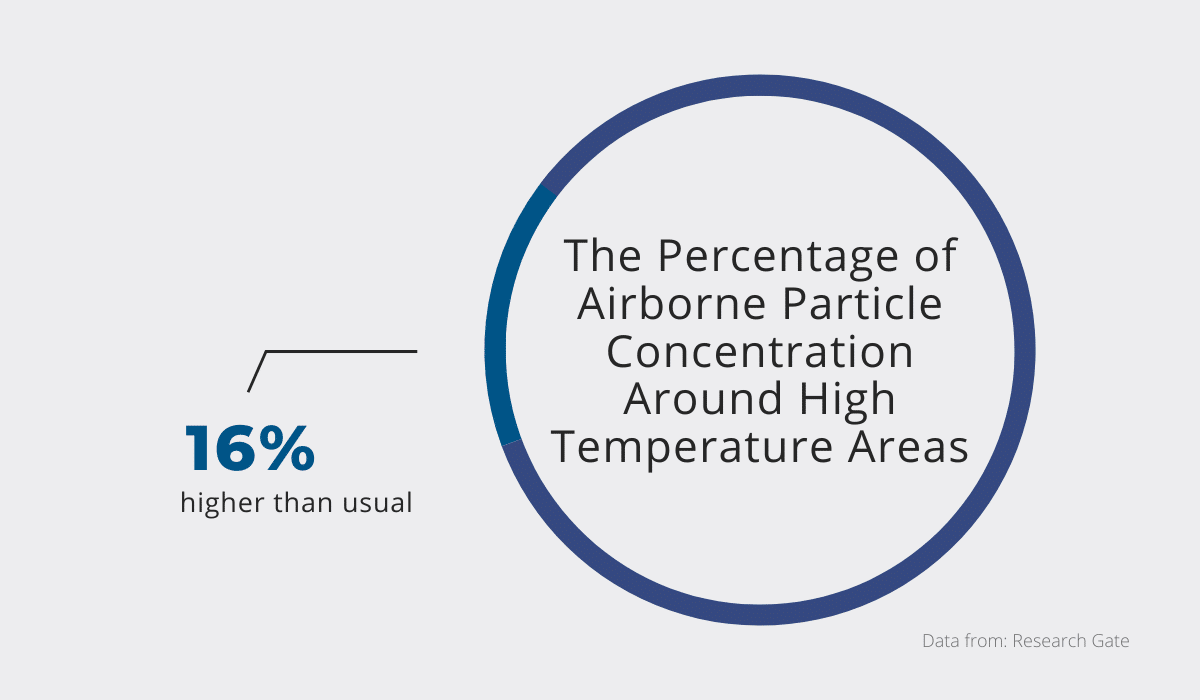
The study found that heat attracted 16% more airborne particles than regular conditions.
Since construction sites get very hot during the summer, you can imagine how much higher this percentage is around the worksite.
The best solution for airborne particles around the construction site is personal protective equipment, which is mandated by the Occupational Safety and Health Administration (OSHA).
You can choose from a variety of PPE that protects against pollutants.
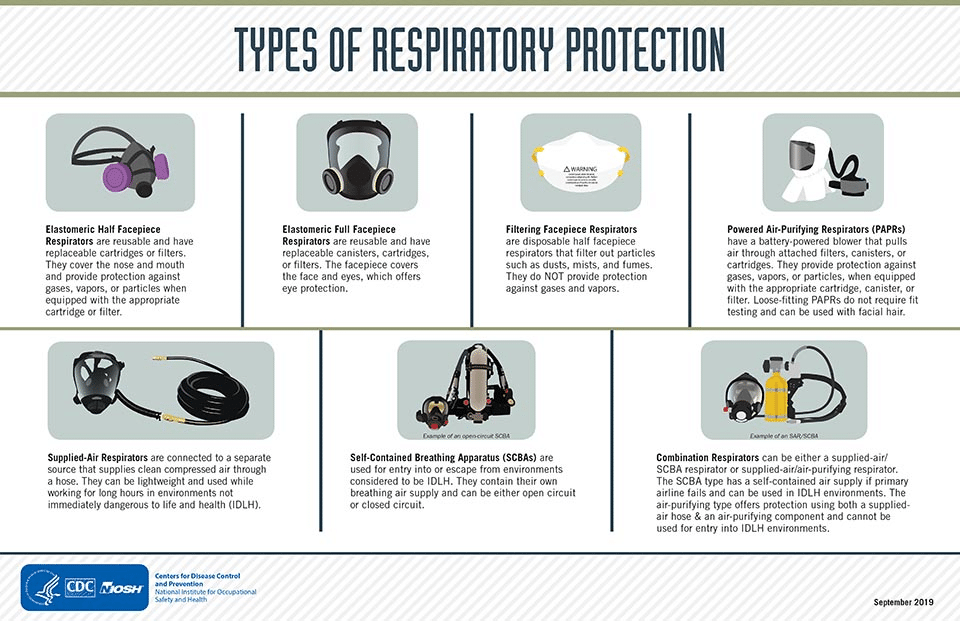
Construction workers commonly use filtering respirators when working with dust and fumes. If you want to protect their eyes, you should opt for a full-face respirator.
Your construction workers should wear respirators during demolition, welding, sanding, and other activities that might create airborne particles.
SiteSafe also recommends spraying the worksite with water since it removes harmful matter.
On top of spraying surfaces and work areas, clean the equipment thoroughly to ensure no pollutants are lingering on its surface.
Prevent damage caused by pollutants by using face masks and spraying the worksite with water to remove them from the air.
Landscaping Activities
Landscaping activities involve anything that changes the feature of a land’s area. However, it’s a thoroughly planned and expertly conducted process that some construction companies perform.
The heat often complicates landscaping because high temperatures make it impossible for certain plants to grow or even exist.
Moreover, the heat sometimes makes you waste resources like water.
If you water grass when the temperature is 95 °F or higher, you’re wasting water because it quickly evaporates, leaving the plant dehydrated.
You’ll have to pay attention to possible issues and the state legislature when offering landscaping services.
For example, the Landscaping and Scenic Enhancement Code states that ¼ of the funds for roadside and highway development have to go towards “planting of native wildflower seeds or seedlings, or both.”
Therefore, if you run a state-funded project, you have to pay attention to this and similar rulings that ensure you plant vegetation that lasts.
So, you either have to find plants that can withstand the heat or wait until fall when the temperatures drop so you can plant vegetation that will take.
If the plants die, your company will likely be ordered to replace them, so you might return to the construction site often during summer.
Doing research is a great way to ensure these problems don’t happen on your construction site. Educate yourself on what vegetation can survive in the summer heat in your climate.
Once you know more about the plants, understand how often you should water them.
Most experts recommend drip irrigation to keep the vegetation hydrated throughout the day and avoid overhydration and dehydration.
This watering system uses micro and mini sprays to keep the plants hydrated throughout the day.

Source: Research Gate
None of your workers will have to manually water the plants, saving you time and money. Most importantly, the plants will get the necessary hydration, and your project will continue smoothly.
High temperatures can affect the type of vegetation you plant and the amount of watering you’ll need to do, which is why it’s essential to research beforehand.
Concrete Curing
Concrete curing is the process of giving “adequate moisture, temperature, and time to allow the concrete to achieve the desired properties for its intended use.”
It might sound complicated, but construction companies always perform this activity.
Even if you have a lot of experience in the industry, you might have issues with concrete curing in the summer months.
After all, the air can get hotter and more humid than usual, which will affect the entire process by speeding it up.
Without proper temperature management, layers of concrete will cure at different times, which will inevitably lead to cracking in the future, and tarnish your reputation, putting off potential customers.
For the most robust concrete, keep the temperature low when pouring.

The lower the temperature, the stronger your concrete will be later on. If the temperature is high on the day you pour, the concrete will cure quickly, but it will be weaker later.
To avoid issues with concrete curing, pour concrete over the more significant areas during the least warm time of day.
This period will usually be nighttime or early morning since the temperatures drop and the sun isn’t out yet. If it’s over 90°F, it would be wise to leave the pouring for another day.
Keep each concrete slab moist before pouring wet concrete on it. Dry concrete will suck the moisture out of the new one, which will result in cracks.
Once you pour the concrete, you have to let it harden and gain strength. To keep the temperature the same, use summer blankets to cover the concrete.
The blankets will maintain the desired temperature. Otherwise, if the days are hot and nights chilly, the temperature changes could affect the concrete and lead to cracking.
Therefore, a summer blanket might be the best solution.
Material Combustion
High temperatures can cause flammable materials to combust and start a fire, which poses a danger to your team.
Combustion happens when materials with low ignition points are left out in the heat. The material goes through self-heating and self-ignites.
However, an outside factor like a spark or a cigarette butt can also set materials on fire.
A worker happens to forget something combustible on the construction site, and—bam!—you have a big problem on your hands.
Of course, the hotter it is, the higher the chances of certain materials igniting. Here are some of the materials known to catch fire spontaneously:
- Compost and hay piles
- Hay
- Charcoal
- Coal
- Cotton
- Oil seed and its products
Wood and plastic, two materials often found on construction sites, are also highly flammable.
If you have any of these materials around your worksite, be extremely careful when handling them.
You should never store anything that can combust around known fire hazards.
Of course, you should also have firefighting equipment at the site if a fire happens. Always have smoke alarms around to warn construction workers of the danger.
The construction site has to be equipped with fire extinguishers and sprinklers.
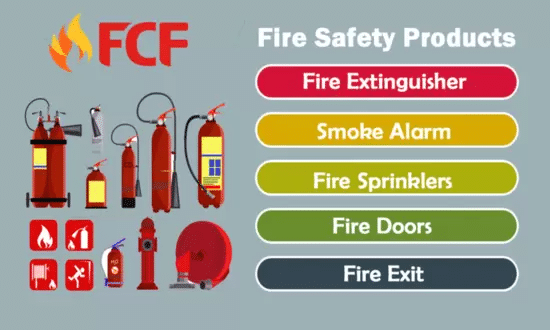
The buildings also have a fire exit and doors so your workers can make it out safely in case of a fire.
To prevent fires in the first place, always know where your materials are. The best way to do this is to use a tool and material tracking software like GoCodes.
You just tag the materials, enter the material data into the software, and you’ll always know where the item is and who is using it.
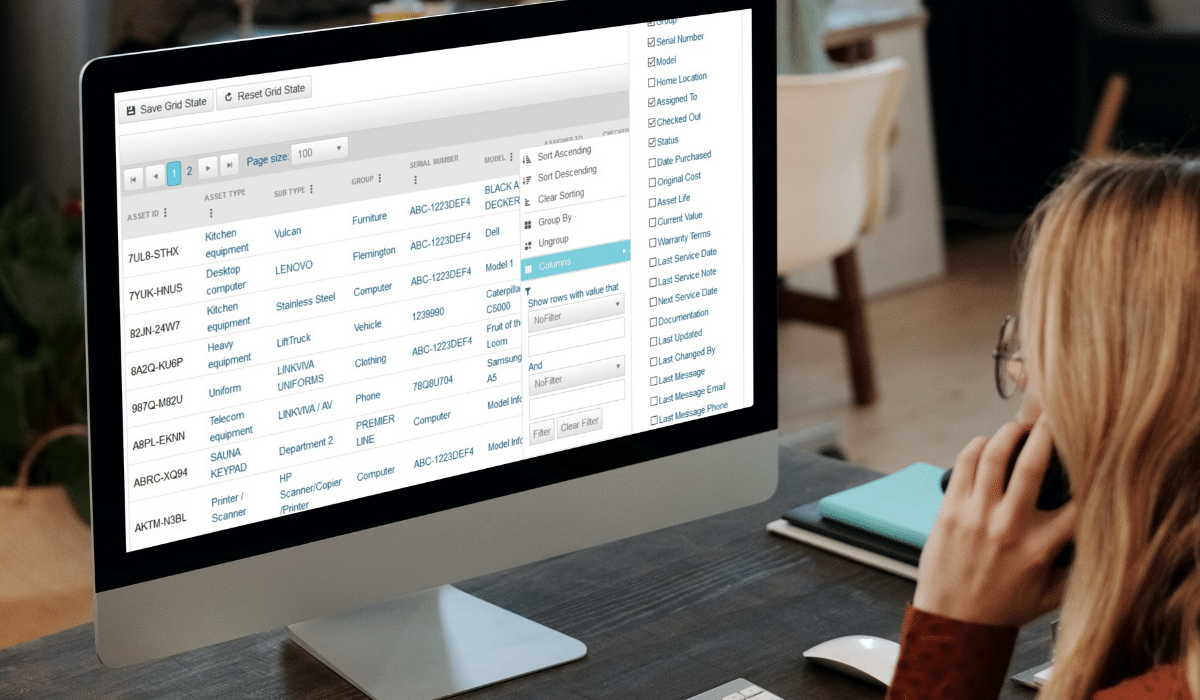
Therefore, your team members won’t be as likely to leave materials lying around, and you can always double-check to ensure everything is where it should be.
Furthermore, don’t leave materials in grassy areas, even if they themselves are not combustible.
Grass is—which means anything you leave around it could go up in flames in high heat. If the materials are flammable, make room for them somewhere air-conditioned or in the shade.
When it comes to the crew, ensure that they park away from vegetation and use designated smoking areas.
You don’t want cigarette buds landing on grass and setting your construction site on fire.
Do everything you can to safely store and track combustible materials around the construction site.
Employee Productivity
Summer can decrease your construction workers’ productivity, which affects the entire project.
Employee productivity is vital for your projects. After all, project plans depend on your workers being effective and performing tasks during a specific period so they can move on to the next.
If your entire workforce suddenly stops being as efficient as usual, your project will slow down significantly.
Summer heat can negatively affect your construction team’s productivity.
The University of Chicago conducted a study to prove how high temperatures affect plant output and worker productivity.
Unsurprisingly, the warmer the temperature, the lower the productivity and, hence, the work.

The same study also found that absenteeism from work increases when the weather is hot, which slows your project even more.
Therefore, if you expect to work during the high summer temperatures, account for more absences and lower productivity when making project plans.
However, if you have to work under such conditions, ensure your team is as comfortable as possible.
The heat wears people out and slows them down, so you should ensure they spend as little time in the sun as possible.
The study suggests automating the part of the work that can be automated to avoid sending workers out in the field during high heat.
They also suggest climate control, like installing cooling equipment at the workplace, as that encourages people to stay at work. In short, think of ways you could protect your workers.
If you can’t install cooling equipment at the site itself, offer longer and more frequent breaks, water stations, and air-conditioned break rooms.
Heat Stress
Heat stress happens when the human body gets overheated to the point of the body failing to control internal temperature. Heat stress can have serious consequences and even end fatally.
Obviously, the likelihood of suffering from heat stress increases in the summer. The sun warms bodies and surfaces like metal, which can lead to burn injuries.
Because of this, you must be prepared for the possibility of heat stress and ensure everyone stays safe.
The best way to prevent serious injuries caused by heat stress is to ensure the team gets plenty of rest and water.
OSHA recommends staying hydrated all day—before, during, and after work. As an employer, provide water breaks every 20 minutes.
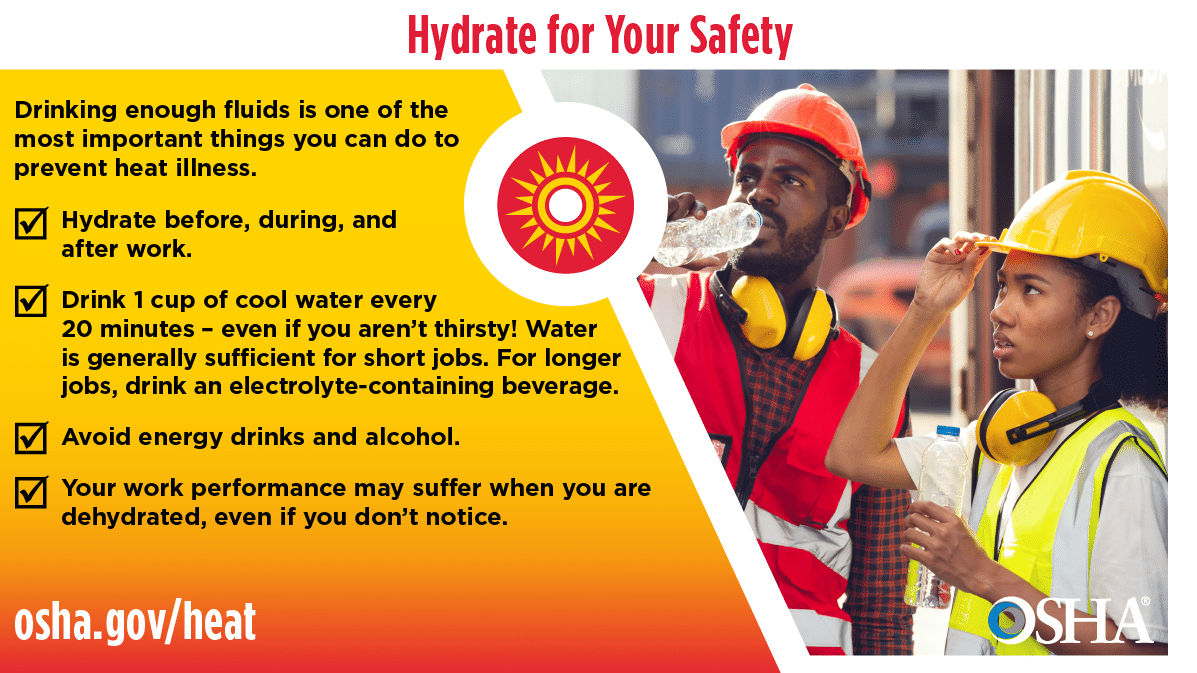
Ensure there is enough cold water for the entire team. Remove any type of alcohol, caffeinated, sugary, or energy drinks from the break room as they can increase body temperature.
The rest stations should be in an air-conditioned space or in the shade to avoid overheating. Also, make breaks obligatory instead of just recommended.
Quality training on the dangers, symptoms, and first-aid in case of heat stress will go a long way. Invest time in it so your team understands what to look out for and how heat can affect them.
Teach them to recognize symptoms in themselves and others. The construction team has to understand what happens to someone affected by heat stress, like:
- Loss of concentration
- Muscle cramps
- Heat rash
- Intense thirst
- Fainting and exhaustion
When they spot these issues, the workers should know how to help the person affected by the heat, for instance, by helping them hydrate, or cool down with cold packs, and letting them rest in the shade.
You’ll prevent severe injuries and death at the worksite through good training.
Heat stress does pose a significant threat to the health and safety at the construction site, but you can work on prevention and training.
Conclusion
Summer weather poses many dangers to your construction workers and the projects.
High temperatures can affect materials, cause concrete cracking and material combustion, and affect the landscaping activities.
What’s even worse, the heat can not only affect your employee’s productivity but can also cause heat stress and lead to serious injuries and death.
The best way to prevent the dangerous effects heat can have on your projects is to be informed, research how to ease the effects, and train your team on staying safe.
If you do all three, you can rest assured that your construction workers will have a much easier time working this summer!





